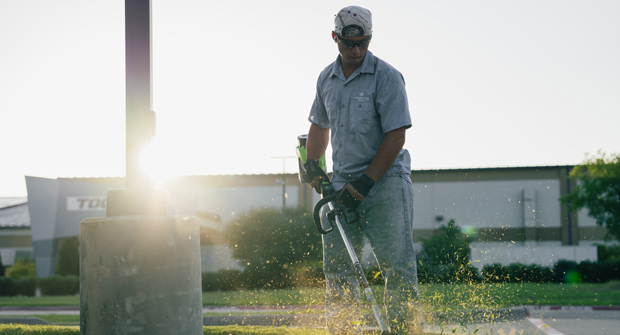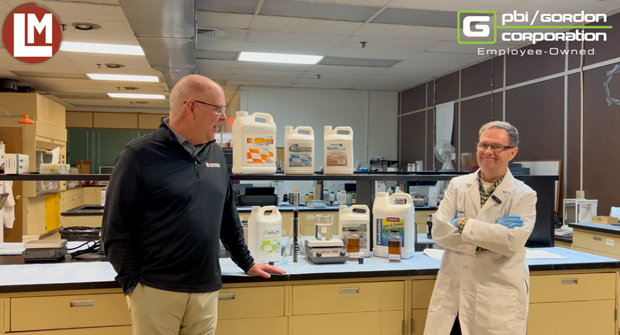[SPONSORED CONTENT] Editorial Director Seth Jones visits the PBI-Gordon lab to meet with Dale Sanson, Ph.D., senior director of formulation development in compliance chemistry, to learn about Aethon Herbicide SL for Turfgrass.
This video is sponsored content by PBI-Gordon.
Transcription:
SJ: Seth Jones
DS: Dr. Dale Sanson
SJ: Hey everybody. It’s Seth Jones, editorial director of Landscape Management magazine. I am at the PBI Gordon laboratory in downtown Kansas City, and I’m being joined by Dr. Dale Sanson. He is the senior director of formulation development and compliance chemistry. Dr. Dale, how’s it going?
DS: Pretty good.
SJ: Good. Well, we’re going to talk about Aethon® herbicide. First, just walk me through the product. What do my readers love it for?
DS: Well, like we were talking before, we initially looked at the two active ingredients, pyrimisulfan and penoxsulam, on a granular, then it migrates onto a fertilizer to make a weed and feed. And then ultimately, we overcame some formulation challenges and were able to put pyrimisulfan and penoxsulam together in an aqueous based, or water based product. And that’s unusual, because those active ingredients are typically formulated as suspension concentrates. So initially it started as a granule, migrated on up into a new technology with Aethon®, has penetration power with a new adjuvant that we put in. It has new technology that allows us to put the pyrimisulfan and penoxsulam together to be physically chemically stable again in the water based product.
SJ: Okay, so run through some of the weeds that will knock out for us.
DS: In the southern market, specifically warm season, we’re looking at dove weed, dollar weed, Virginia button weed, ground ivy. And then when you look further, you get your sedges, the annuals. You also get the perennials, purple, yellow. So very, very comprehensive weed package for that warm season, southern turf.
SJ: Okay, and talk to my guys. Tell me about the properties that make this a special product for them.
DS: Well, you know, we touched on the fact that several folks are coming back and asking, you know, that granular version you had, we like that kick of that fertility. Can we do the same thing by adding some fertilizer into the spray tank? And the answer is absolutely. And the reason that is so, I’ve got a sample of the formula here. Very free flowing, very fluid, makes it very easy to add to the spray tank. Characteristic brown color that is characteristic of many of our products. That’s because of the sequestering agent that’s in the product. And what that means, it’s a fancy word for going into the spray tank, getting those hard water ions, like iron, two, magnesium, manganese, sequestering them and preventing any interaction between the formula and the fertilizer. The penetrant that we have in here is going to also make it such that you can add into fertilizer. Wales is an acronym for the proper mixing order that you should use and follow whenever you’re adding things into a spray tank. Google that, you go to any university extension center, they’re going to give that proper mixing order. So we’re going to shortcut that. We’re going to jump ahead and I’m going to show you the right way to add Aethon® in with a liquid fertilizer. When you’re adding these together, as I said, the Wales method, you want to add a soluble liquid, which Aethon® is, into your spray tank. And look at that. Look how pretty. In the formulation world, we call that bloom, how easy that goes into the spray tank. On a real world scenario, I’d let that sit for a couple minutes and let mix. And while that’s mixing, what I want to do is kind of talk about an SDS. When you’re mixing multiple partners in a spray tank, you definitely want to refer to section nine of your SDS and look at the pH. Look at the pH of the two partners you’re wanting to put together. If you’re within two pH units, you’re probably okay. You start going extreme. One maybe three, one be maybe seven, you’re probably doomed to have some issues. So look at that SDS. Okay. Couple minutes and it’s very clearly become uniform. Then we’re going to add a liquid fertilizer. Lots of different liquid fertilizers on the market: UAN, urea, nitrates, very robust to many of them. We’re going to add that next, and look how nice that goes together. Very uniform, very clear, very little agitation. I would advise, though, in a big spray tank to up that agitation a little more, make sure you’re getting the uniform mix, and there you go. You’re guaranteed to succeed for the day.
SJ: Okay, well, Dr. Dale, thanks for the tips and tricks on how to use Aethon® out in the field.
DS: Absolutely.
SJ: Okay. Thank you. Everybody, this is Dr. Dale. I’m Seth Jones, thanks for watching us here on Landscape Management TV.


